Jerusalem is a blockbuster destination, make no mistake. But I wanted to see some more of the country, and I really couldn’t leave without floating in the Dead Sea. On Saturday I managed to get myself to Tel Aviv, which turned out to be reasonably simple despite the fact that the buses don’t run on Shabbat. What does run is a system of “shared taxis” called sherut, and it wasn’t hard to find one of them. That took me to the Tel Aviv central bus station, and then I managed to blunder around long enough to locate the right local sherut to get downtown to my hostel.
I went to Tel Aviv to hash, and it was the first time I’ve been an easy 3-minute walk from the start of a run, which was luxurious. The Holy Land Hash House Harriers were a friendly bunch, mostly Americans, and they welcomed me as I’ve come to expect. Lots of them had done an overnight race 30km run through the desert the night before, so there was a larger walking contingent that usual and the run was mercifully short. This was good because I was still generally plague-ridden and could really feel it when running. And not only was the run short, and conveniently located, it included a beer stop half way through at a bar that served the largest beers I’ve ever seen!
I should also add the the Holy Land HHH were the first hash I’ve visited that gave me a memento of my run with them – a patch to sew onto my running shirt. (Never mind that it was a patch for a different hash, the Thirsty Knights HHH. It’s made up of the same people, they just run on Thursday nights instead. Get it?) Oh, and I had a nice time Saturday night after the run hanging out with Susan and Tina having beers, even though they took me to that crazy bar that had been blown up 6 years before (“If we can’t sit here and eat nachos, then the terrorists have won.”) We also went to a bar right out on the beach and I tried smoking shisha which was a bit weird, and didn’t really taste like much, so I’m not sure I really see the point.
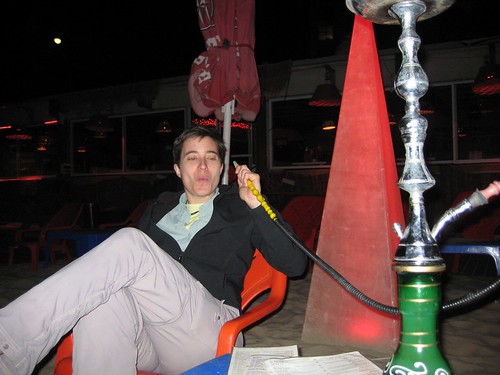 It’s all about trying new things, right?
It’s all about trying new things, right?
Tel Aviv is a beautiful city full of beaches and waterfront walkways, and I desperately wanted to go for a nice long run. On Sunday morning I suited up, but after about 5 minutes my chest and throat were on fire and I had to stop. It was really disappointing because the place was full of runners who kept blowing past me on my dejected trudge back to the hostel.
I consoled myself with a big, leisurely Sunday breakfast of shakshuka, which is a traditional dish of stewed tomatoes and peppers baked in the oven, with an egg poached in the middle of it. Not bad, but a bit on the soupy side. I spent the rest of the day wandering through a bit of Tel Aviv and walking up to Jaffa where there was a big flea market, a weird art installation, a passion fruit slushy, and a pathetic visitor’s centre (where they should be ashamed to be charging 8 shekels admission, even though that’s only $2.25). It was a quiet day, but reasonably relaxing. I had an evening of blogging and turned in early because I planned early start the next day.
On Monday morning I was picked up from the hostel for my day trip to Masada and the Dead Sea. It was a smallish bus, whose first stop was at the Ahava Centre, a thinly disguised (actually completely blatant) attempt to get the tour participants to buy Ahava Dead Sea skin care products. We got herded off the bus to watch a 4 minute video on Ahava products that depicted happy men clad in pristine white overalls gingerly snipping twigs from therapeutic bushes or scooping small trowels of Dead Sea mud into gleaming glass cylinders. Very sensitive and sustainable, though I suspect the actual harvesting uses more backhoes than trowels. After the video we were funneled into the store. I hate this kind of captive consumerism, but even I found myself thinking, “I need shampoo anyways…” before I snapped out of it and realized I didn’t need $10.00 Dead Sea shampoo.
Once we shook off the shackles of commercialism it was on to Masada, which the LP describes as “a desert mesa rising high above the Dead Sea, which figures prominently in the Jewish psyche.” It’s best know as the spot where, in 66 AD, 960 Jews chose suicide rather than be captured by besieging Roman forces led by Peter O’Toole. It’s an impressive sight and a really long way up. People with more time and energy hike all the way to the top. We took a convenient cable car, and got some great views along the way.
At the top were more of my favourite things – rocks and Roman ruins! There’s the remains of a whole settlement up there, including Herod’s palace (he really got around, that Herod). There was also a very clever water collection and storage system and yet another Roman bath. (I think I’ve seen too many of these by now, I can practically recite along with the guides: apodyterium, frigidarium, tepidarium, calderium…).
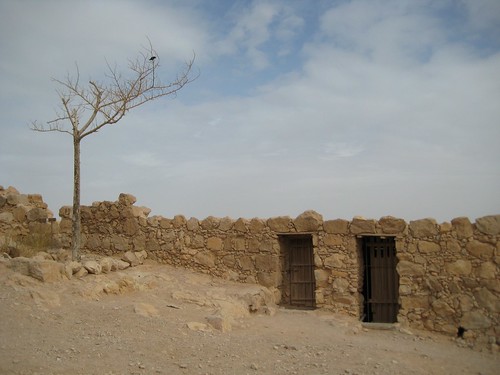 Not the baths. Instead, a picturesque bit of wall and a nice tree.
Not the baths. Instead, a picturesque bit of wall and a nice tree.
There’s one thing I liked about how the restoration was done at Masada, and I think it should be adopted in some form by all archeological restorers. All around the site along the walls there was a thick black line painted, snaking up and down at different levels. Our guide explained that this was the line of restoration – everything below it was original, everything above it was a recreation. I thought it was a brilliantly simple way to give visitors a good sense of what they were really seeing, and it made me wonder how much of every other archeological site I’ve seen in the last six months was original and how much was not.
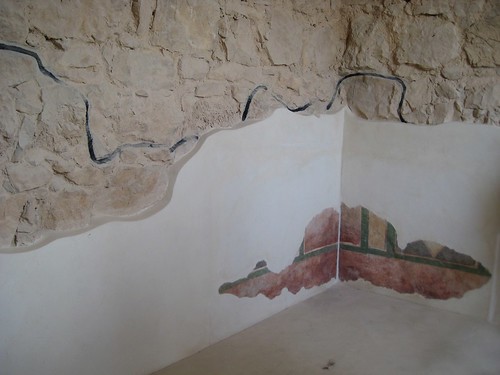 See? Original frescos below, recreated wall above
See? Original frescos below, recreated wall above
What did I not like at Masada? I did not like that a small bottle of water cost 10 shekels, and I did not like that the associated Visitor’s Centre had a banner for the “Masada Muselogical Experience”. Honestly, must everything be a bloody experience? Can I not just go to a museum?
By this point you must be thinking, '”But what about the Dead Sea? This post is supposed to be about the Dead Sea!” Well after Masada it was time for the main event and the bus zipped us down to the sea. (And I do mean down – it’s the lowest point on earth, 1,385 feet below sea level). It was a strange sight. The Dead Sea is rapidly disappearing – apparently it dropped 1.5 metres last year alone. I find that astonishing. It must mean you can poke a stick in the beach at the water line and come back a day or two later and see a noticeable difference. It also means that the Ein Gedi spa built along the shore is now so far from the water they use a shuttle to take people back and forth. Most of this water loss is because water from the Jordan River – the only source flowing into the Dead Sea – is being diverted irrigation.
Of course I went in. There are change rooms and showers and lockers just like any well-appointed beach, but the actual area for swimming was very small – cordoned off with a line of buoys. And you all know the gag, right? The water of the Dead Sea is so salty (33% salt – more than 8 times that of normal seawater) that it’s impossible to sink.
 Here’s the obligatory photo of me floating.
Here’s the obligatory photo of me floating.
It’s fun, but the water is also incredibly harsh. I put just a dot of it on my tongue to see what it tasted like (don’t try and tell me you wouldn’t do the same thing) and it was awful. Not just salty, but really chemically too. They tell you not to put your head under water or get it in your eyes. You’re not even supposed to splash around. It actually kind of stung, especially any tiny cuts or scrapes I had.
 I also went into the black mud and covered my self from head to toe but my appointed photographer did not have a very steady hand, so you get a photo of other people in the mud instead.
I also went into the black mud and covered my self from head to toe but my appointed photographer did not have a very steady hand, so you get a photo of other people in the mud instead.
After rinsing the mud off in the sea, and gingerly wiping off my face, I gradually noticed that it felt like my skin was kind of burning, especially my face. So I got out to try the hot spring, which was nice and warm, but just as harsh. Pretty soon I had to get out and clean off with some fresh water. But that wasn’t the end of me and the Dead Sea. The water itself is… tenacious. It felt almost oily on the skin and was hard to wipe off. Later that night I realized how insidious it really is. When I was walking from the shore back up to the change rooms I put my bare, still wet feet right into my shoes. The water from my feet soaked into the inside of my shoes a bit, but I figured it would dry soon enough. Not so. There’s now an oily film all over the inside of my shoes, which naturally transfers to the outside of my socks, which naturally transfers to the shiny tile floor of my hotel room, making the whole place sort of skating-rink-ish. Also, the drips of water that landed on the outside of my shoes created big dark oily stains that didn’t really come off despite vigorous scrubbing. So I still have Dead Sea with me to this day.
And then it was time for the ride back to Jerusalem. A bit long, and sort of tiring, but at least the view was good.

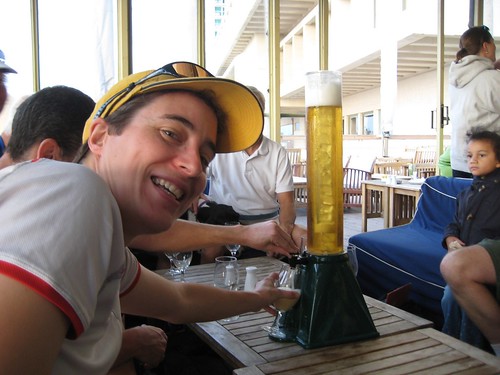
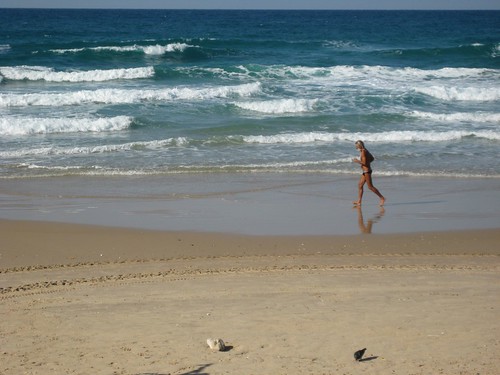




2 Comments:
I really like the " picturesque bit of wall and a nice tree"...You have some great shots...I would love to enlarge a few and frame them for my new house.
p.s. I didn't notice any of the people in the mud shot writhing in pain or screaming...the sign did say: "Dangerous - Boiling Mud!"
Post a Comment